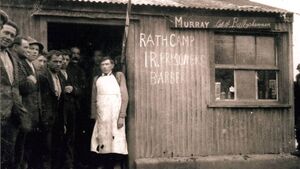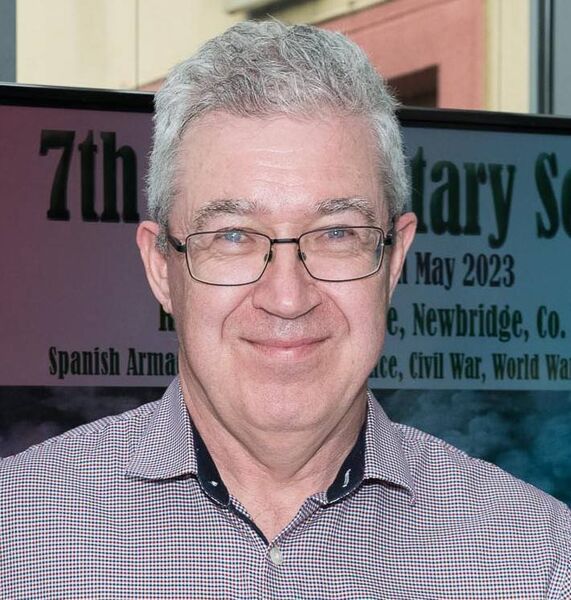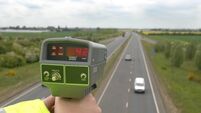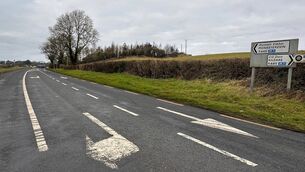Kildare's jail breaks gets its own book

Republican internees queue for a haircut at Rath Camp on the Curragh, 1922
Archvist and prolific author James Durney will launch a book with enormous Kildare references in the Curragh Military Museum on Wednesday called .
The book will be officially launched by Art McCoy whose father John features heavily in the book, after he orchestrated the escape of Frank Aitken and a 100 others from Dundalk in July 1922, and then subsequently escaped from Tintown Camp on the Currragh Plains.
The event will take place on Wednesday at Naas Library at 7pm.
“Anyone that has grown up in mid-Kildare in the early 1970s will recall the escapes from the Curragh Camp and Portlaoise Prison,” said the 62-year-old Naas native, whose day job is an archivist in the former town library at the Harbour.

“Sirens would sound in Naas, the Curragh and Kildare town, signalling that something major had happened and calling all troops back to barracks to aid in the search for escapees or man roadblocks and checkpoints,” he explained.
Astonishingly, James thinks this is his 25th book, saying: “I lost count after 20”, in a writing career he began in 1997.
“It took me about a year to write it, when I put my mind to it,” he explained.
“It was an idea I had for a while after my sister found an old album in the house, after our mother died, that I had bought my father in the 80s called ,” he said.
“Songs like , a lot of them were banned in the 1970s off the radio, so the only way to hear them was to buy the album,” he said.
“I approached Conor Graham at Merrion Press in Newbridge with the idea, and he wanted me to go back further, to 1865 when the leader of the Irish Republican Brotherhood James Stephens was helped by our own John Devoy to escape after only 11 days in jail,” said James.
Escapes from both the Curragh and Portlaoise feature in the book.
During the War of Independence and the Civil War, the Curragh plains was home to some of the largest and most important internment camps in the country.
The Rath Camp, opened on 1 March 1921 and housed up to 1,300 men, but within days Rory O’Connor and an accomplice walked out the front gate.
In September 1921, during the Truce and while negotiations for the Anglo-Irish Treaty were ongoing, over 50 republican internees tunnelled their way out of here.
With the outbreak of the Civil War the following year, Newbridge Cavalry Barracks was converted to an internment centre for anti-Treaty IRA prisoners, and it was from here the greatest escape in Irish prison history occurred over a weekend in October 1922 when 112 prisoners escaped through a tunnel into the sewer.
35 men from County Kildare escaped the biggest group by county, while twelve men from Carlow fled through the sewer and tunnel.
William ‘Squires’ Gannon, then only 21, made a successful escape and was not recaptured. Gannon was later winner of two All-Ireland medals (1927 and 1928) and was the first captain to raise the Sam Maguire Cup.
Tintown Internment Camp, on the Curragh plains, held about 5,000 internees, and apart from intermittent escapes – Peadar O’Donnell also walked out the front gate – another 70 internees tunnelled their way to freedom.
One of them was the aforementioned John McCoy, originally from Mullaghbawn, Co. Armagh, but who later settled in Kill.
He was father of Olympic boxer Colm McCoy (Rome, 1960), and Art and John of McCoy Motors, Lucan, the latter of which will launch the book on 29 August.
The Curragh was back in business after the IRA launched the Border Campaign in 1956 and again, the became a holding centre when the Troubles erupted in 1968, when the Glasshouse Military Prison was used to house republican prisoners.
The Curragh was chosen in the likely expectation that its remoteness would preclude riots which had taken place inside and outside Mountjoy Jail in 1972.
However, within weeks a major clash took place on the Curragh Plains when a demonstration of 2,000 people, organised by Provisional Sinn Féin and People’s Democracy, degenerated into a full-scale riot, involving around 200 breakaway demonstrators, gardaí and riot-gear-clad soldiers.
This was the first time riot troops had been deployed in the Republic.
After a helicopter escape from Mountjoy by three republicans – Seamus Twomey, Kevin Mallon and J. B. O’Hagen – all IRA prisoners held at Mountjoy and the Curragh Camp were transferred to the maximum security in Portlaoise on 9 November 1973.





